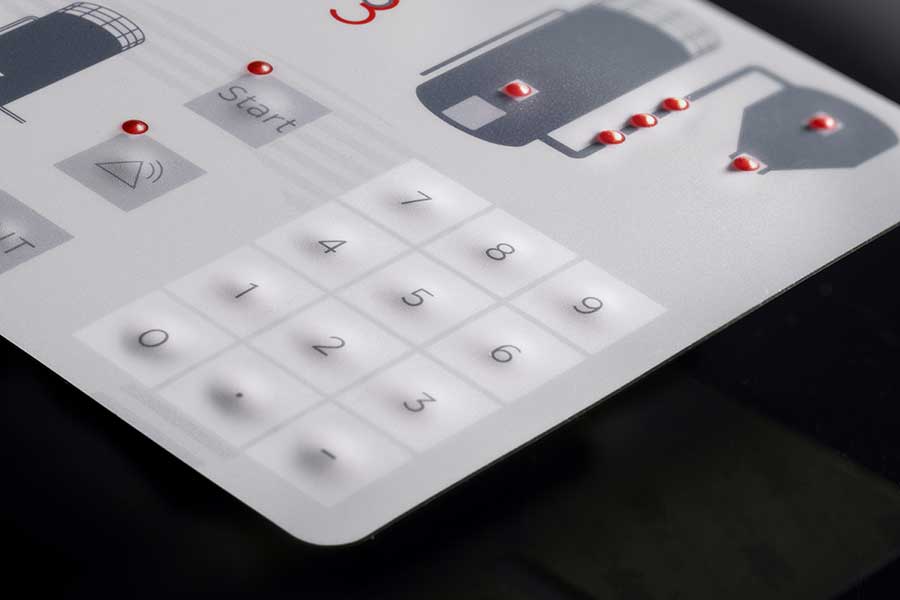The Importance of Membrane Switches in Building Intuitive Interfaces
The Importance of Membrane Switches in Building Intuitive Interfaces
Blog Article
Membrane Layer Change Technology: The Secret to Reputable and Affordable Interfaces
Membrane switch innovation has emerged as an essential element in the style of customer interfaces, giving both integrity and cost-effectiveness throughout a varied range of applications. As we explore the complex benefits of membrane buttons, their potential for advancement raises questions regarding future applications and evolving trends.
Recognizing Membrane Layer Switch Modern Technology
Membrane layer switch innovation is a widely used user interface service in various electronic tools, supplying a smooth blend of functionality and design. This modern technology integrates multiple layers of products, typically including a graphic overlay, spacer layer, and a circuit layer. The visuals overlay displays the user interface components, while the spacer layer divides the circuit layer from the overlay till a user triggers a button.
When pressure is related to the overlay, the circuit layer finishes the electrical circuit, sending a signal to the gadget. This system permits various setups, consisting of tactile comments and backlighting alternatives, improving customer interaction. Membrane switches are generally made using long lasting materials such as polyester or polycarbonate, guaranteeing durability and resistance to environmental aspects like moisture and dust.
The adaptability of membrane layer changes allows their application in diverse industries, including medical gadgets, consumer electronics, and commercial controls. Their portable design permits integration into space-constrained environments, supplying an effective interface without jeopardizing visual charm. Understanding the complexities of membrane switch technology is important for manufacturers and designers seeking to develop reliable and effective human-machine interfaces.
Secret Benefits of Membrane Buttons
While different interface options exist, membrane switches over offer unique advantages that make them a favored choice in various applications. Among the key benefits is their longevity; membrane switches are designed to withstand extreme environmental problems, consisting of moisture, dirt, and temperature changes, guaranteeing durable performance. This strength substantially lowers the need for constant substitutes, therefore reducing overall maintenance costs.

Furthermore, membrane layer switches are lightweight and compact, making them suitable for applications where area is limited. Their inconspicuous layout contributes to a smooth look without compromising capability.
Cost-effectiveness is also a significant benefit, as the production process for membrane layer changes has a tendency to be cheaper contrasted to standard mechanical buttons. This affordability, incorporated with their dependability and ease of setup, settings membrane switches over as a practical service for a wide variety of industries seeking reliable and reliable individual interfaces.
Applications Throughout Numerous Industries
Just how do membrane layer buttons adjust to the varied needs of various markets? Membrane switch innovation is progressively identified for its versatility, making it appropriate for a broad variety of applications throughout multiple fields.
In customer electronics, membrane layer buttons offer a small solution for push-button controls and home appliances, improving individual experience via intuitive layout. Additionally, the commercial industry leverages membrane switches for machinery control panels, taking advantage of their resistance to rough environments, such as wetness and dirt.
Armed forces and aerospace applications additionally use membrane layer switches for their reliability and ability to endure severe conditions, guaranteeing operational performance in essential scenarios. The food and beverage industry adopts these switches for automated systems, where sanitation and convenience of operation are critical (membrane switch). Inevitably, membrane layer switches are tailored to satisfy the distinct needs of each industry, verifying their essential function in modern-day innovation interfaces
Style and Customization Options

In the realm of membrane right here switch innovation, design and personalization options play a pivotal duty in enhancing functionality and customer communication. These switches can be customized to satisfy details operational demands and aesthetic choices, making them versatile components in different applications.
Among the main personalization choices is the format of the button itself, which can be developed to fit unique customer interfaces and ergonomic factors to consider. By adjusting the form, size, and setup of switches, producers can develop intuitive designs that facilitate simplicity of use. In addition, the incorporation of different shades and visuals overlays permits for branding and enhanced presence, making certain that users can quickly recognize functions.
Moreover, membrane buttons can be crafted with different responsive feedback systems, such as raised switches or audible clicks, to boost the user experience. Different materials can likewise be picked for sturdiness and ecological resistance, addressing variables such as wetness, temperature variations, and chemical direct exposure.
Eventually, the considerable design and modification alternatives available in membrane layer switch modern technology equip organizations to create tailored services that not just satisfy practical requirements yet also align with their branding and operational demands.

Future Fads in Membrane Buttons
As membrane switch innovation proceeds to develop, future fads are significantly concentrated on enhancing individual experience and incorporating sophisticated capabilities. One substantial trend is the assimilation of touch-sensitive and capacitive technologies into standard membrane layer switches. This growth permits for more user-friendly user interfaces, supplying tactile comments while this page keeping a sleek style.
An additional arising trend is the use of eco pleasant materials, driven by the growing demand for lasting production practices. Manufacturers are looking for to lower their carbon impact by making use of recyclable substratums and low-impact inks, straightening with international sustainability objectives.
Moreover, the increase of the Internet of Points (IoT) is triggering the incorporation of clever attributes into membrane layer buttons. Boosted connectivity alternatives will certainly enable gadgets to communicate with each other, allowing for seamless combination right into broader systems.
Furthermore, innovations in printing innovations, such as digital printing, are enabling for higher style adaptability and modification. This enables producers to generate intricate layouts and vibrant colors cost-effectively.

Verdict
In final thought, membrane switch technology stands for a crucial technology in user interface style, providing considerable advantages in resilience, personalization, and cost-effectiveness. As advancements continue to arise, especially in touch-sensitive user interfaces and sustainable materials, link the possibility for membrane layer changes to enhance user experience and functionality continues to be promising.
Report this page